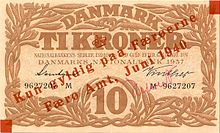Faroese crown
| Faroese crown | |
|---|---|
| Country: |
|
| Subdivision: | 100 oyrur |
| ISO 4217 code : | no |
| Abbreviation: | kr |
|
Exchange rate : (August 24, 2020) |
1 kr = 1 DKK (fixed) 1 EUR = 7.4435 kr 1 CHF = 6.9171 kr |
The Faroese Crown (Faroese: króna) is the currency of the Faroe Islands . One crown is divided into 100 oyrur . It is not an independent currency, but a local version of the Danish krone , with Faroese banknotes in circulation but using Danish coins. It is therefore linked 1: 1 to the Danish krone. The Faroese banknotes are printed with motifs from the fauna and flora of the Faroe Islands.
history

When the Faroe Islands were cut off from Denmark in World War II and occupied by Great Britain , the Faroe Islands had their own currency. Initially, from June 1940, it was Danish kroner that was overstamped, and from November then own notes, which were printed in London but issued nominally by the Danish National Bank .
On April 12, 1949, a law was passed that the Faroe Islands would get their own money, and thus their own account at the Danish National Bank, where the Faroese banknotes have been printed since then. The principle is relatively simple: the Faroese state government receives exactly the equivalent of the money that it has deposited into this account from the Danish National Bank. This money in turn comes from the tax revenue of the financially autonomous archipelago and the possible profit of its state-owned companies, such as Atlantic Airways or Postverk Føroya . All Faroese kronor in circulation therefore represent the Faroese credit in Copenhagen .
The Faroese Krone has existed as a means of payment since 1951, when a separate 5-kroon note was issued. In 1954 the 10-kroner note followed. The common Danish coins function as coins.
As with the Danish krone, there are now banknotes of 50 (since 1967), 100 (1964), 200 (2004), 500 (1980) and 1000 (1980) kroner. The format is exactly the same as the Danish banknotes.
A new series of banknotes with the values 50, 100, 200, 500 and 1000 kroner has appeared since 2001. The watercolors on the respective backs are by the Faroese painter Zacharias Heinesen .
The Faroese and Danish banknotes can be exchanged for free in their respective issuing countries and are accepted everywhere. However, outside of Denmark, it will be difficult to get Faroese banknotes from a bank.
On March 29, 2005, a statement by the Danish government made it clear that in the event of Denmark joining the euro zone, the Faroe Islands (analogous to Greenland ) can keep the krona if they so choose. According to the will of the Sjálvstýrisflokkurin party, however, it could turn out the other way round: while the Danes were against joining the euro zone, the Faroe Islands applied to join in August 2009.
- See also: Coin find from Sandur , money system of the Faroe Islands in the Middle Ages , Faroe Islands in the Second World War
Web links
- Eik-Bank ( Eik Banki , Faroese)
- Danish National Bank on Faroese banknotes (English, Danish)
- The banknotes of the Faroe Islands
Individual evidence
- ↑ Euro wanted as currency in Faroe Islands. Retrieved March 26, 2011 .
- ↑ Uppskot til samtyktar um at taka upp samráðingar um treytir fyri evru sum føroyskt gjaldoyra. (PDF; 32 kB) Retrieved on March 26, 2011 (Faroese).
